RMI 协议的全称为 Remote Method Invocation (远程方法调用)协议。
RMI 应用程序通常包含两个独立的程序,一个服务器和一个客户端。典型的服务器程序会创建一些远程对象,使对这些对象的引用可访问,并等待客户端调用这些对象上的方法。典型的客户端程序获取对服务器上一个或多个远程对象的远程引用,然后调用它们上的方法。RMI 提供了服务器和客户端通信和来回传递信息的机制。这样的应用程序有时被称为分布式对象应用程序。
首先,实现一个最基本的RMI服务
一个RMI由三部分组成
|
1
2
3
|
RMI Registry
RMI Server
RMI Client
|
其中,Registry的生成包含于RMI Server中。
RMIServer
|
1
2
3
4
5
6
7
8
9
10
11
12
13
14
15
16
17
18
19
20
21
22
23
24
25
26
27
28
|
import
java.rmi.Naming;
import
java.rmi.Remote;
import
java.rmi.RemoteException;
import
java.rmi.registry.LocateRegistry;
import
java.rmi.registry.Registry;
import
java.rmi.server.UnicastRemoteObject;
public
class
RMIServer {
public interface IRemoteHelloWorld extends Remote {
public String hello() throws RemoteException;
}
public
class
RemoteHelloWorld extends UnicastRemoteObject implements IRemoteHelloWorld {
protected RemoteHelloWorld() throws RemoteException {
super
();
}
public String hello() throws RemoteException {
System.out.println(
"call from"
);
return
"Hello world"
;
}
}
private void start() throws Exception {
RemoteHelloWorld h
=
new RemoteHelloWorld();
LocateRegistry.createRegistry(
1099
);
Naming.rebind(
"rmi://127.0.0.1:1099/Hello"
, h);
}
public static void main(String[] args) throws Exception {
new RMIServer().start();
}
}
|
⼀个RMI Server分为三部分:
⼀个继承了 java.rmi.Remote 的接⼝,其中定义我们要远程调⽤的函数,⽐如这⾥的 hello()
⼀个实现了此接⼝的类
⼀个主类,⽤来创建Registry,并将上⾯的类实例化后绑定到⼀个地址。这就是我们所谓的Server了。
RMIClient
|
1
2
3
4
5
6
7
8
9
10
11
12
|
import
java.rmi.Naming;
import
java.rmi.NotBoundException;
import
java.rmi.RemoteException;
public
class
TrainMain {
public static void main(String[] args) throws Exception {
RMIServer.IRemoteHelloWorld hello
=
(RMIServer.IRemoteHelloWorld)
Naming.lookup(
"rmi://10.253.132.182:1099/Hello"
);
String ret
=
hello.hello();
System.out.println( ret);
}
}
|
rmi协议,格式为: rmi://host:port/Object
这里的host为127.0.0.1或者cmd命令行ipconfig命令中查询到的本机地址
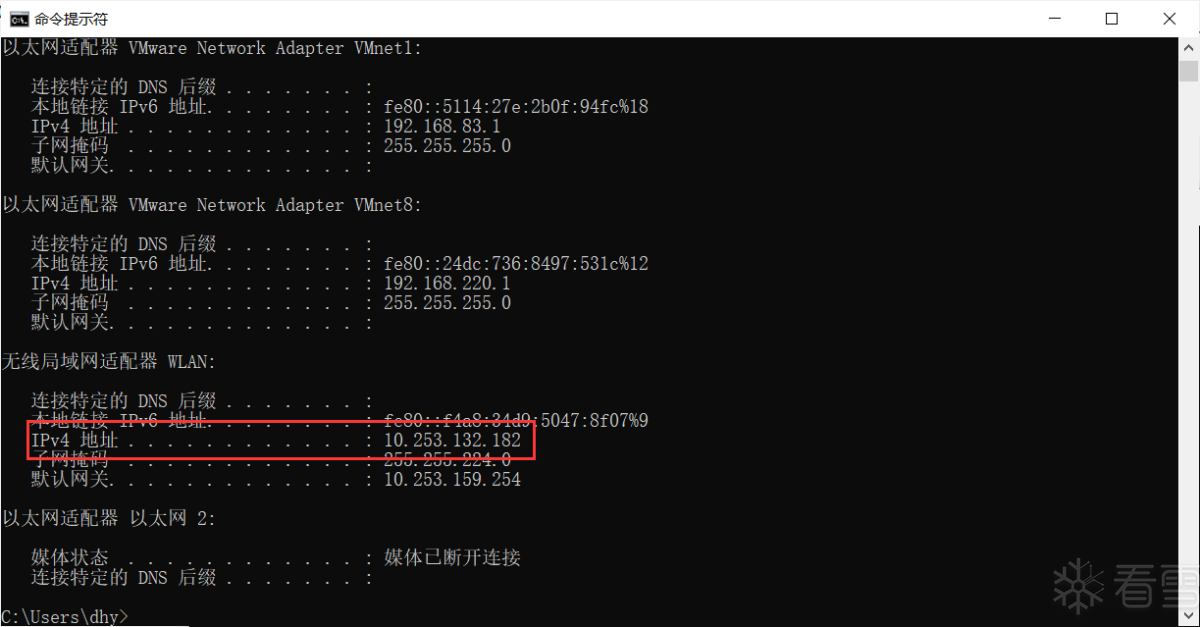
|
1
|
这里有一点小疑问,host使用上面两个,即
192.168
.
220.1
和
192.168
.
83.1
都可以达成同样的效果。这是VMware给本机建立的虚拟网卡,同样能够让rmi协议定位到本机。但是有一个比较奇怪的点,我打开wareshark抓包抓不到Client与Registry和Server的TCP与rmi包。只有在输错host时能够抓到tcp retransmission包
|

修改host做了上述实验,先运行RMIServer,再运行RMIClient,这里我运行了3次,效果如下
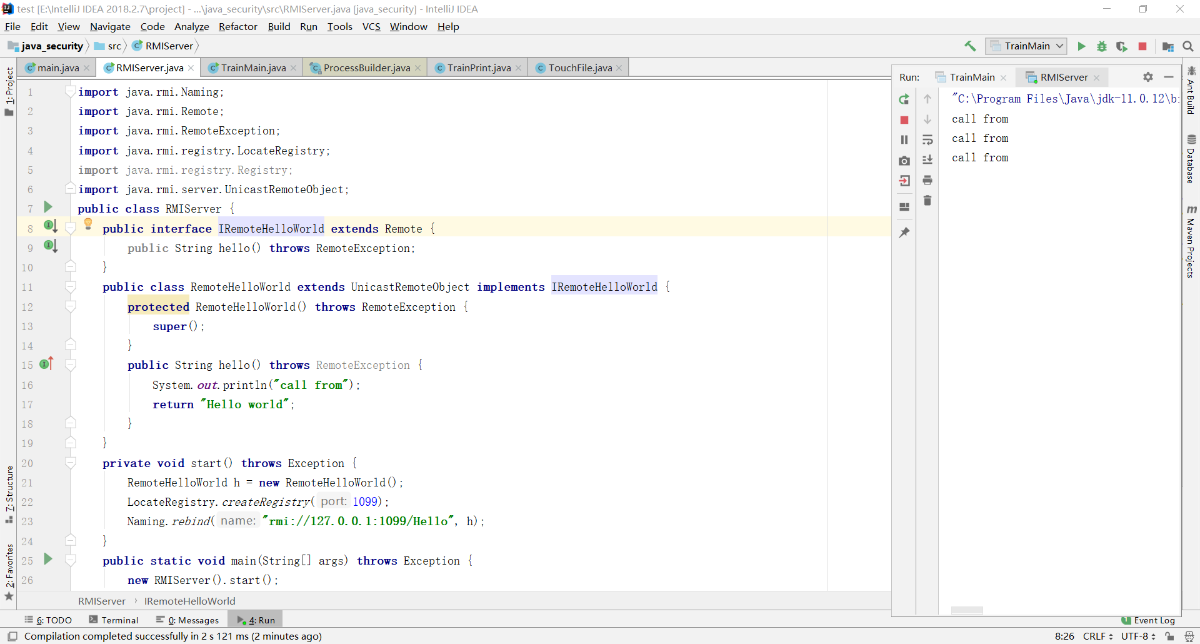
远程调用RMI测试
相信刚刚接触到rmi的同学都会有这样一个疑问,既然rmi叫Remote Method Invocation (远程方法调用)协议,那么我们能不能在云服务器上搭建RMIServer再本地远程调用方法呢。这里我就来试试:
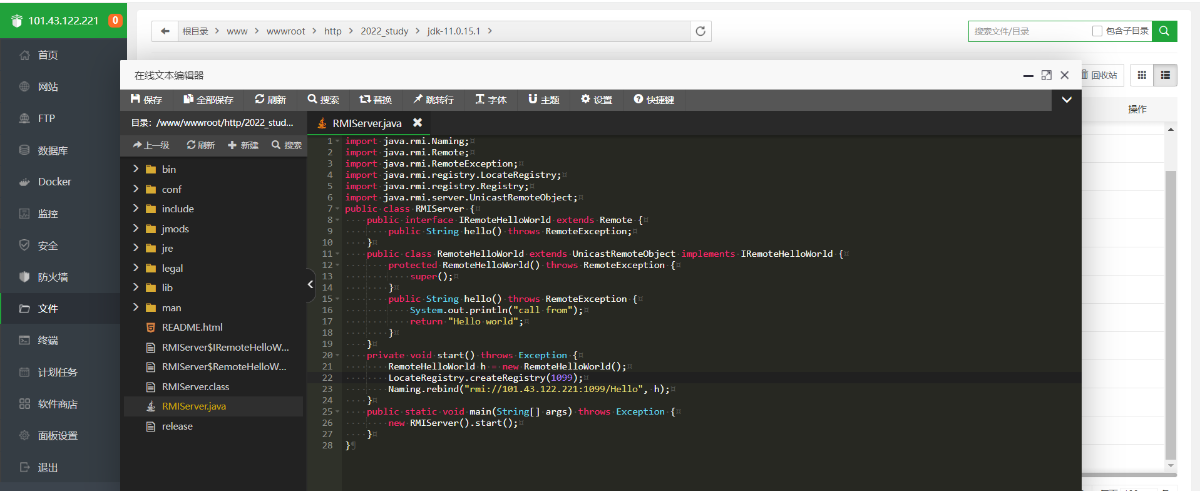
在云服务器上编写以上代码。
|
1
2
|
javac RMIServer.java
java RMIServer
|
产生报错
|
1
|
Error: Could
not
find
or
load main
class
RMIServer
|
搜索得可能是环境变量有问题。
|
1
2
3
4
5
6
7
8
9
10
11
12
13
14
15
16
17
|
打开
/
etc
/
profile
set
java environment
JAVA_HOME
=
/
www
/
wwwroot
/
http
/
2022_study
/
jdk
-
11.0
.
15.1
PATH
=
$PATH:$JAVA_HOME
/
bin
:$JAVA_HOME
/
jre
/
bin
CLASSPATH
=
.:$JAVA_HOME
/
lib:$JAVA_HOME
/
jre
/
lib
export JAVA_HOME CLASSPATH PATH
保存退出 source更新环境变量
source
/
etc
/
profile
|
再次运行RMIServise,运行成功。
没高兴多久,报了下面的错误
server端
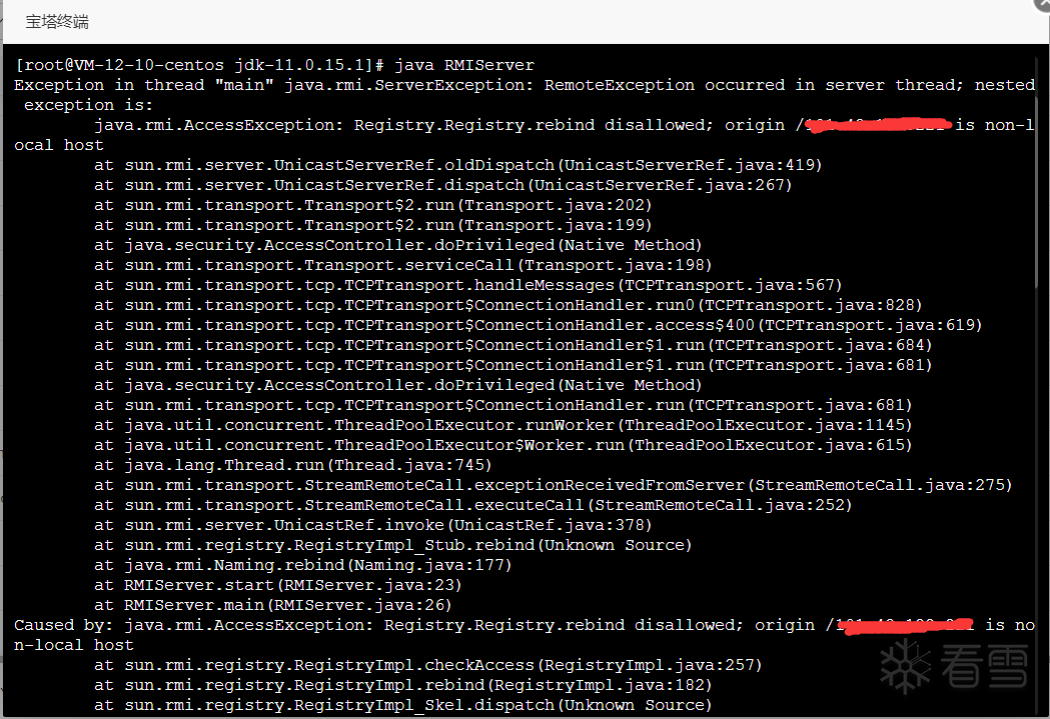
client端

通过报错信息来看,应该是不允许不是本机的机器进行访问。竟然是远程方法调用为什么不能远程调用呢。
在stackoverflow找到了以下解释
|
1
|
正如错误所示,您无法与远程注册中心绑定、重新绑定或解除绑定。你必须在同一个主机上运行。这是RMI的基本安全措施。
|
RMI原理概述
接下来就是抓包检验RMI的运行流程,p牛的java安全漫谈中能够抓到rmi协议包,但是我在本机并未抓到,在此留下疑问。
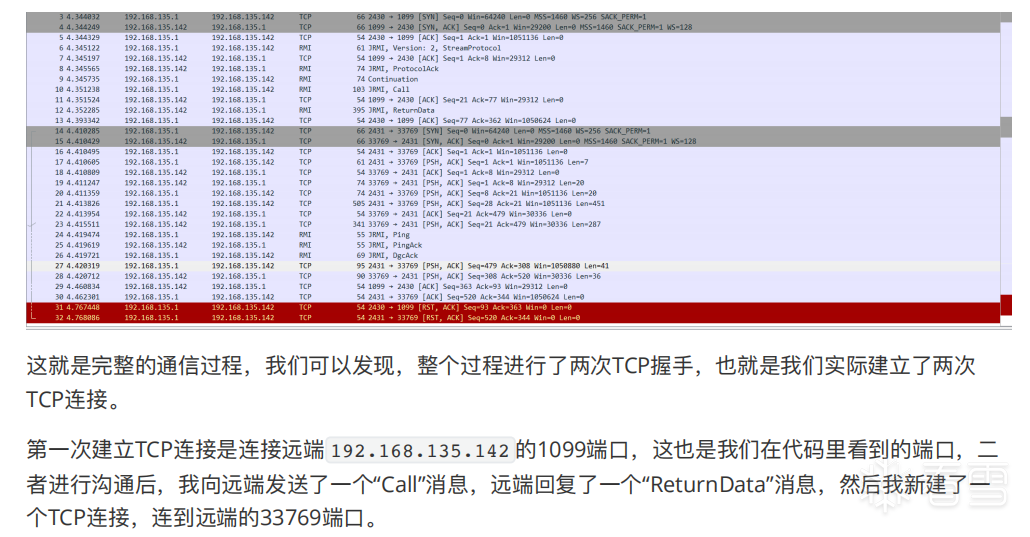
根据整个通信过程可以总结出,整个RMI远程调用方法的流程如下
|
1
|
⾸先客户端连接Registry,并在其中寻找Name是Hello的对象,这个对应数据流中的Call消息;然后Registry返回⼀个序列化的数据,这个就是找到的Name
=
Hello的对象,这个对应数据流中的ReturnData消息;客户端反序列化该对象,发现该对象是⼀个远程对象,地址在
192.168
.
135.142
:
33769
,于是再与这个地址建⽴TCP连接;在这个新的连接中,才执⾏真正远程⽅法调⽤,也就是 hello()
|
用通俗一点的话来说,就是client首先向远端Registry发送一个请求,请求其中的某个对象,Registry收到client的请求后告诉client这个对象,但是这个对象是远程对象(即源代码在远端),然后client再与server建立连接,远端server执行完请求的方法,再把结果告诉client。为了容易理解什么是远端对象,接下来我们利用以下代码打印输出远端对象,看看远端对象到底是什么样的
|
1
2
3
4
5
6
7
8
9
10
|
public
class
TrainMain {
public static void main(String[] args) throws NotBoundException, RemoteException, MalformedURLException {
RMIServer.IRemoteHelloWorld hello
=
(RMIServer.IRemoteHelloWorld)
Naming.lookup(
"//101.43.122.221:1099/Hello"
);
System.out.println(hello);
String ret
=
hello.hello();
System.out.println( ret);
}
}
|
结果如下
|
1
|
Proxy[RMIServer$IRemoteHelloWorld,RemoteObjectInvocationHandler[UnicastRef [liveRef: [endpoint:[
169.254
.
218.208
:
49154
](remote),objID:[
-
259c9b84
:
183733a63d6
:
-
7fff
,
-
604087336640089995
]]]]]
|
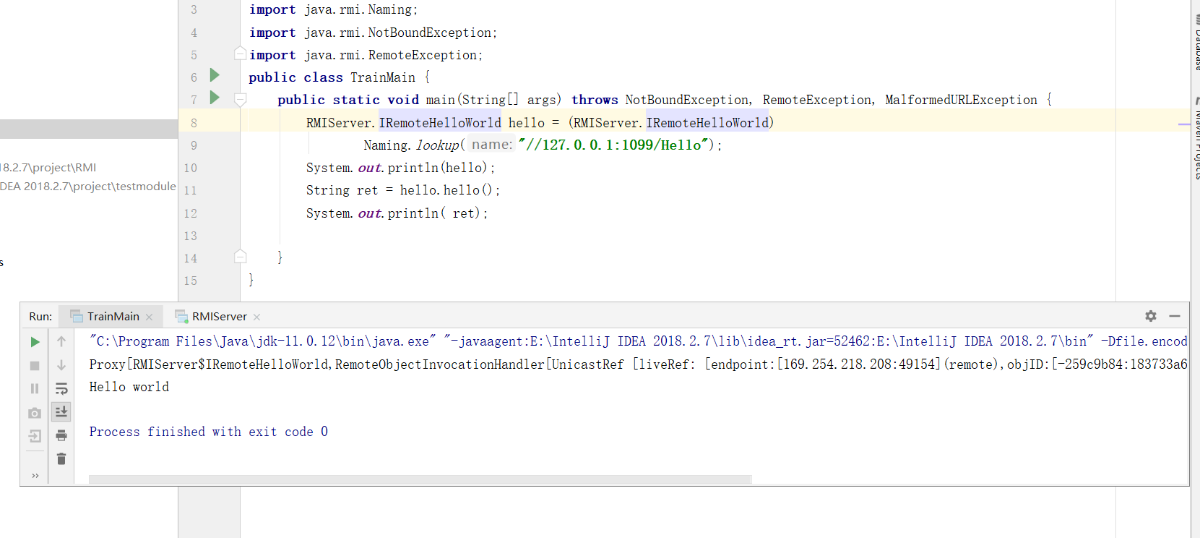
可以看到169.254.218.208就是远程对象的地址,49154就是请求远程对象所需要连接的端口。
远程调用问题的解决
首先要解决的是AccessException的问题,经过多方搜索及尝试,基本能定位到问题的缘由。首先,我改换server中rebind函数中的host来测试rebind到底在干一件什么事
如果我们在远端运行以下代码
|
1
2
3
4
5
6
7
8
9
10
11
12
13
14
15
16
17
18
19
20
21
22
23
24
25
|
public
class
RMIServer {
public interface IRemoteHelloWorld extends Remote {
public String hello() throws RemoteException;
}
public
class
RemoteHelloWorld extends UnicastRemoteObject implements IRemoteHelloWorld {
protected RemoteHelloWorld() throws RemoteException {
super
();
}
public String hello() throws RemoteException {
System.out.println(
"call from"
);
return
"Hello world"
;
}
}
private void start() throws Exception {
RemoteHelloWorld h
=
new RemoteHelloWorld();
LocateRegistry.createRegistry(
1099
);
System.out.println(
"ok1"
);
Naming.rebind(
"rmi://101.43.122.221:1099/Hello"
, h);
/
/
自己云服务器的ip
System.out.println(
"ok2"
);
}
public static void main(String[] args) throws Exception {
System.out.println(
"start"
);
new RMIServer().start();
}
}
|
运行时,控制台输出start ok1,但没有输出ok2,这意味着rebind命令并未执行完毕,过一段时间后便会报之前展示的AccessException漏洞。这时我把Naming.rebind()语句换为以下语句再进行启动
|
1
|
Naming.rebind(
"rmi://127.0.0.1:1099/Hello"
, h);
|
会发现没有产生报错,rebind执行成功。
本机使用以下代码进行访问
|
1
2
3
4
5
6
7
|
public static void main(String[] args) throws NotBoundException, RemoteException, MalformedURLException {
RMIServer.IRemoteHelloWorld hello
=
(RMIServer.IRemoteHelloWorld)
Naming.lookup(
"//127.0.0.1:1099/Hello"
);
System.out.println(hello);
String ret
=
hello.hello();
System.out.println(ret);
}
|
此时会发现控制台输出了hello远端对象,不过还是产生了报错
|
1
2
3
|
Proxy[RMIServer$IRemoteHelloWorld,RemoteObjectInvocationHandler[UnicastRef [liveRef: [endpoint:[
127.0
.
0.1
:
40509
](remote),objID:[
-
141e8e8c
:
1837365c720
:
-
7fff
,
2932857538888970532
]]]]]
Exception
in
thread
"main"
java.rmi.ConnectException: Connection refused to host:
127.0
.
0.1
; nested exception
is
:
java.net.ConnectException: Connection refused: connect
|
结论:以上实验证明了rebind函数中的host为远端函数的地址,client向server发起请求后,server回复相应的对象的远端地址就为rebind中的host。在以上案例中client接受到的远程对象地址在127.0.0.1,便向本机发起了远程对象访问请求,但这个远程对象明显是在远程服务器注册的,所以产生了报错,在127.0.0.1找不到该远端对象。
一番搜索后终于解决了这个问题,很多网上的资料都是在本地起的server又在本地搭client,像我这样在云服务器起server,在本地用client调用远端方法的较少。这一部分解决了的文章中又有大部分是在云再开一个进程专门rebind,这样就能rebind到服务器ip上。
我在这里终于是找到了一个方法配置,在main函数开始加上如下代码
|
1
|
System.setProperty(
"java.rmi.server.hostname"
,
"101.43.122.221"
);
|
这样程序就将本机名与ip绑定了起来,此时再使用
|
1
|
Naming.rebind(
"rmi://loaclhost:1099/Hello"
, h);
|
就可以将对象绑定到服务器ip了。
此时再分别运行server和client,client又产生了另一个报错
|
1
2
|
java.rmi.ConnectException: Connection refused to host:
101.43
.
122.221
; nested exception
is
:
java.net.ConnectException: Connection timed out: connect
|
在Oracle官网社区找到了答案。
(低级错误,服务器端口没开放。。)但是这时候问题又诞生了,远程对象的端口是随机给出的,我该如何让他始终使用同一个端口呢。答:写一个类继承Socket生产类,我们定制socket产生方式,使用以下代码
|
1
2
3
4
5
6
7
8
9
10
11
12
13
14
15
|
public
class
CustomSocket extends RMISocketFactory {
@Override
public ServerSocket createServerSocket(
int
port) throws IOException {
if
(port
=
=
0
)
{
port
=
33457
;
}
return
new ServerSocket(port);
}
@Override
public Socket createSocket(String host,
int
port) throws IOException {
System.out.println(
"host:"
+
host
+
" port:"
+
port);
return
new Socket(host,port);
}
}
|
修改server程序如下:
|
1
2
3
4
5
6
7
8
9
10
11
12
13
14
15
16
17
18
19
20
21
22
23
24
25
26
27
28
29
30
31
32
33
34
35
36
37
|
public
class
RMIServer {
public interface IRemoteHelloWorld extends Remote {
public String hello() throws RemoteException;
}
public
class
RemoteHelloWorld extends UnicastRemoteObject implements IRemoteHelloWorld {
protected RemoteHelloWorld() throws RemoteException {
super
();
}
public String hello() throws RemoteException {
System.out.println(
"call from"
);
return
"Hello world"
;
}
}
private void start() throws Exception {
RemoteHelloWorld h
=
new RemoteHelloWorld();
LocateRegistry.createRegistry(
1099
);
System.out.println(
"ok1"
);
Naming.rebind(
"rmi://loaclhost:1099/Hello"
, h);
System.out.println(
"ok2"
);
}
public static void main(String[] args) throws Exception {
System.setProperty(
"java.rmi.server.hostname"
,
"101.43.122.221"
);
try
{
CustomSocket cs
=
new CustomSocket();
try
{
RMISocketFactory.setSocketFactory(cs);
} catch (IOException e) {
e.printStackTrace();
}
}catch (Exception e){
e.printStackTrace();
}
System.out.println(
"start"
);
new RMIServer().start();
}
}
|
激动人心的测试!

成功!这样我就能在服务器运行server且能用任意一台机器远程调用方法还只占用1099和33457两个端口啦!
以上就是本期的全部内容啦,简简单单的一个远程连接问题居然能花3天时间来解决,RMI这块知识网上确实比较欠缺的,都是上来就讲漏洞讲攻击了,我把我学习RMI原理的细节在这里摊开来讲,也希望其他小白也能借此快速入门!









